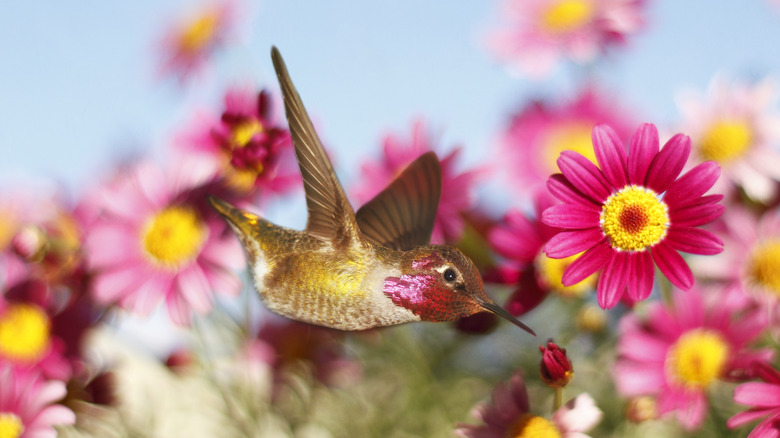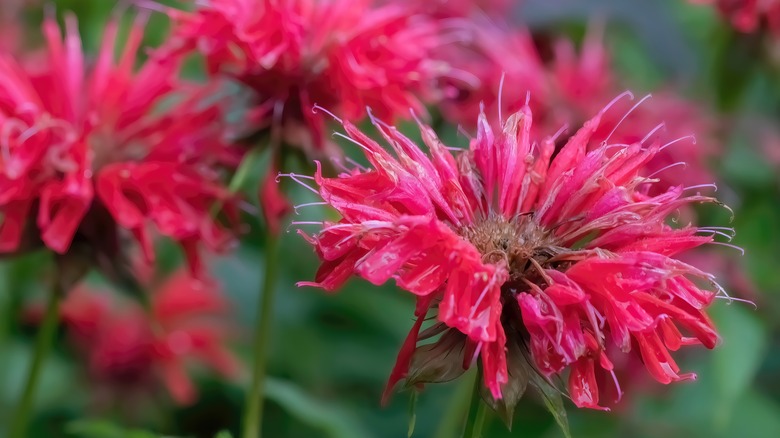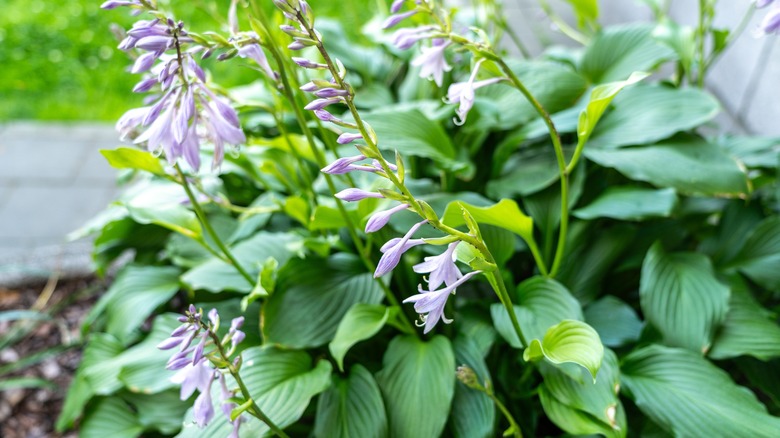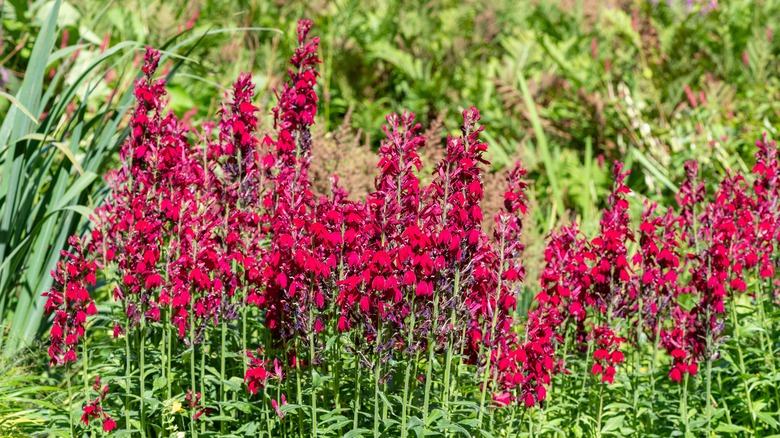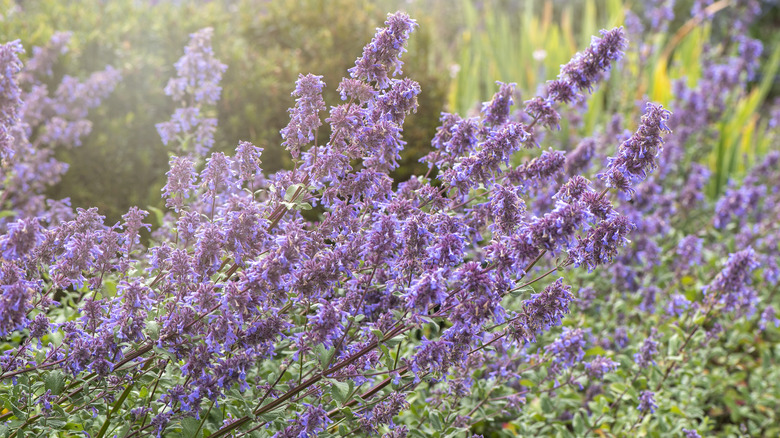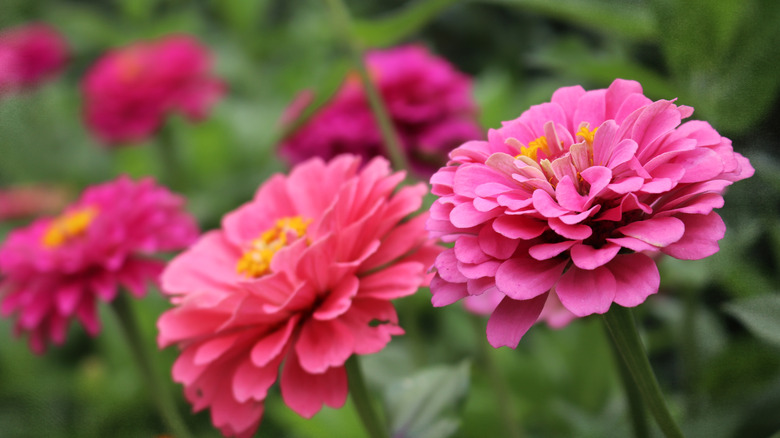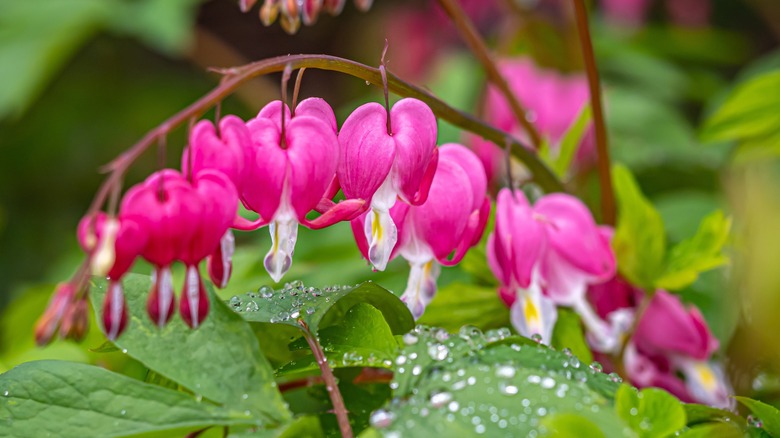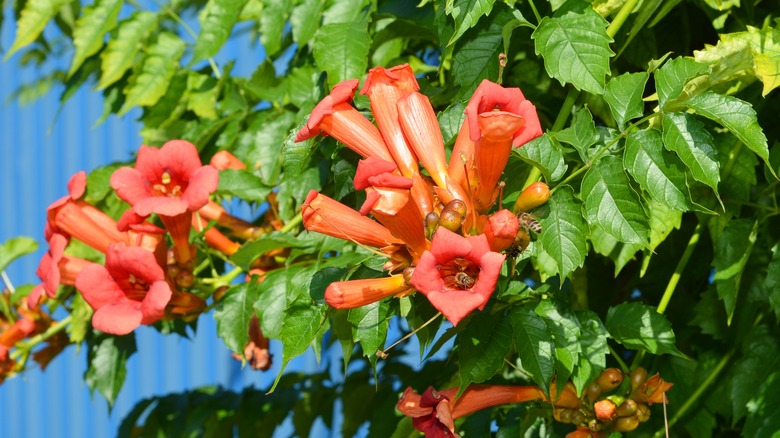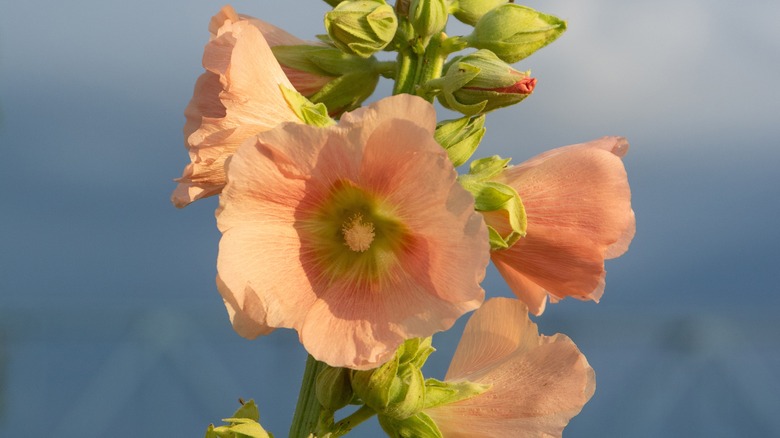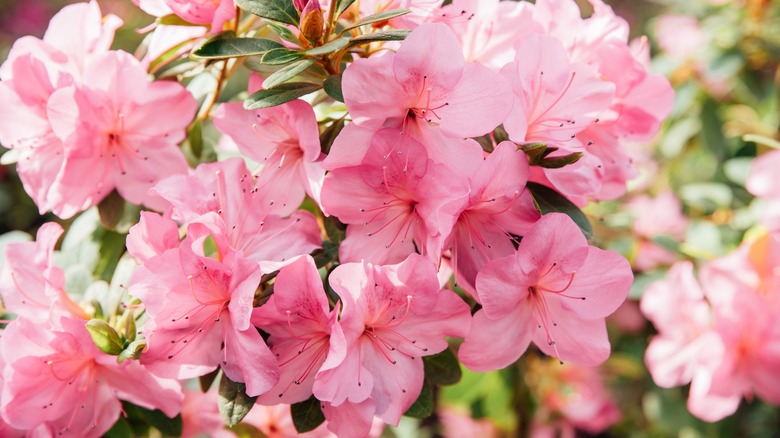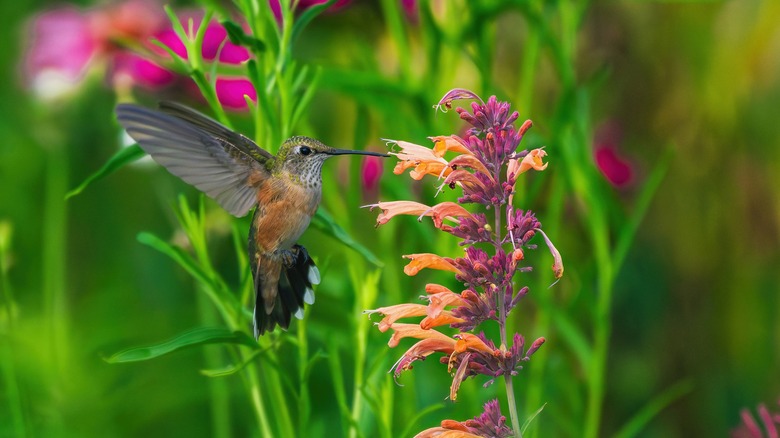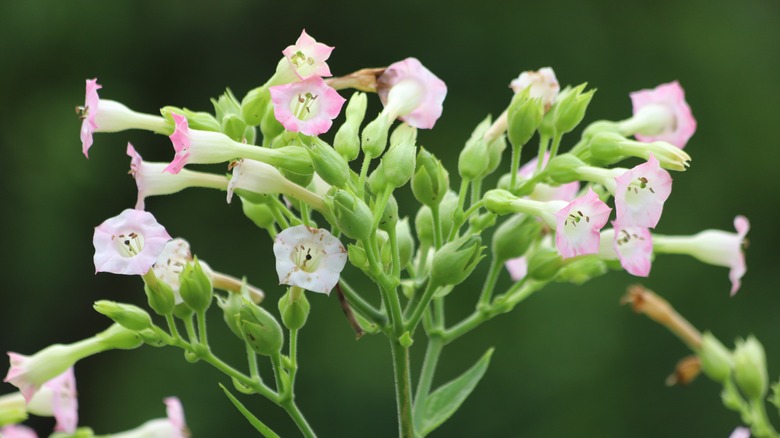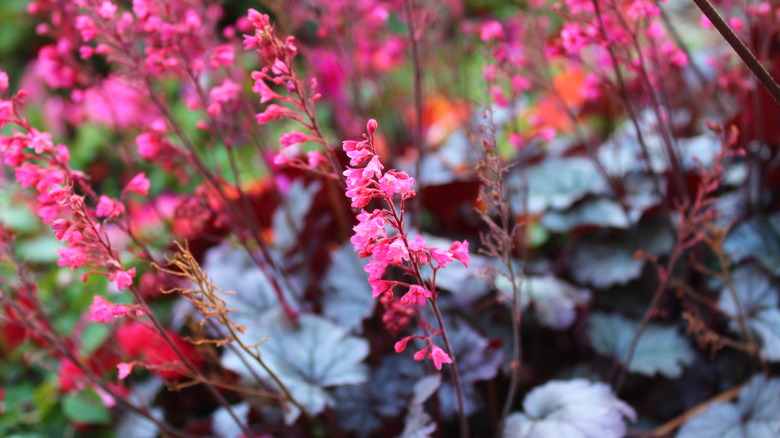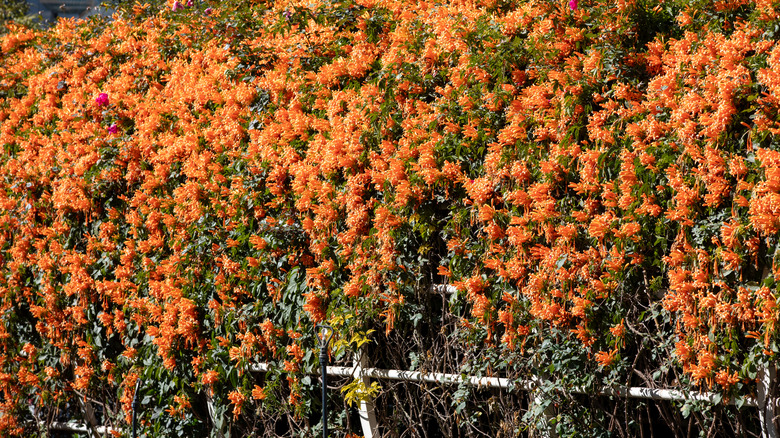13 Stunning Plants That Will Attract Hummingbirds To Your Garden
It would be difficult to not want to attract hummingbirds to your yard. Once you see the bright flash of these colorful little birds hovering in the air and burying their beaks into a flower, you're hooked. Hummingbirds must rank among the coolest of all flying animals. With the ability to beat their little wings 75 to 200 times in a single second, hummingbirds are fast, agile, and totally adorable.
However, apart from their obvious good looks, hummingbirds serve as one of the most beneficial birds in your yard. While they don't go after pests the same way owls or goldfinches will, hummingbirds are among the most effective pollinators out there. Because they get so close to flowers, their feathers will cling onto the pollen, and then spread it around when they zoom away.
So, now that you're in the know, you definitely want to attract hummingbirds to your yard, right? Well, good! Because we have a list for you of 13 plants that will attract these little birds to your yard, and also look absolutely stunning.
Bee balm
Bee balm is an amazingly colorful plant that is fantastic at attracting pollinators, and also serves as an excellent companion to roses. Blooming between June and July every year, these hardy little perennials produce medium-sized flowers that look almost like little flames depending on the variety of color. Instead of fanning outward, they shoot up in little tufts of white, yellow, red, or orange, and then proceed to droop downwards.
Bee balm also emits an enticing scent throughout the garden. It may not be as strong as that of a rose, but you will definitely notice its presence. However, whether or not we can smell it is irrelevant. It's a strong attractor for hummingbirds as it alerts them to the presence of the bee balm's nectar, which they love.
Hummingbirds have long beaks which contain equally long tongues. They are able to reach inside some of the flowers and suck the nectar out from the base of the bloom. The sugars provided by the nectar help fuel the hummingbird, allowing it to keep the pace it needs in order to stay off the ground.
Hosta
You might think that you need incredible amounts of sunshine in order to grow the types of plants that hummingbirds love. This is true to a certain extent, but you can still draw hummingbirds to your yard if you have shadier corners. And as far as shade plants go, there are some shade-loving perennial flowers that you can plant that hummingbirds absolutely love. One of those plants are hostas.
Hostas are primarily known for their enormous green fanning foliage. They can grow in almost total shade, and are perfect at filling out awkward spaces in your garden. Yet, if you give them just a little bit of daylight, hostas will bloom beautiful, long white flowers that grow out of the center of the plant and rise above the foliage like little beacons.
Thanks to the size of the flowers and their shimmering colors, hummingbirds will be attracted to them thanks to the ease with which they can extract the nectar. It's very easy for them to reach their beaks into the long, tube-shaped blooms. So, don't lose hope if you've got shade. You can still bring great color and definition to your yard, plus attract some of the most fun and colorful birds around.
Cardinal flower
As you will see with further entries on this list, the family of bellflowers are going to be very attractive to hummingbirds. This is because bellflowers, characteristically, have bell shaped blocks that open up from a central stem. This openness allows for easy access to the nectar in the flower, which is why hummingbirds love them so much.
As such, the first variety of bellflower we have on this list is the cardinal flower. Named after the higher ranking members of the Catholic Church, and not for the bird, the blooms of the cardinal flower are shaded in the exact red as the Cardinals robes. The blooms exit as small tubes from a central stalk, and droop downwards in a submissive bow.
The red of the flowers is also what attracts hummingbirds. Red is a hummingbird's favorite color. This is likely because red is very easy to spot from a distance, but also because the nectar of red flowers is noticeably richer than other types of flowers. They therefore provide the hummingbird with the most fuel.
Catmint
A strikingly beautiful member of the mint family, catmint is among the most popular mints to grow in your garden. They are a hardy plant that will continue to bloom in large batches of tufted stalks for several years. Catmint gives off a wonderful, light peppery scent that can ride through your garden on the coattails of an afternoon breeze. That scent is also what draws in the hummingbirds.
Though not a bell flower, catmint stalks are covered in great numbers of small, bell-shaped blooms. These little florets provide the hummingbird with an amazing amount of food all from one plant. The catmint blooms come in a lovely shade of deep purple, which creates an attractive sight in the garden, but often causes the catmint to be mistaken for lavender.
Apart from merely making your garden attractive to hummingbirds, catmint can also be consumed safely. The leaves make for a lovely herbal tea that has a mild minty flavor that is not nearly as overpowering as other varieties of mint. You can also just cut the stalks and leave them around your home for lovely cut flower centerpieces.
Zinnia
Zinnias are one of those flowers that are impossible not to love. Though they can be planted as a perennial, they are more commonly sown as an annual owing to the fact that they grow so easily. As a member of the aster family, zinnias explode with colorful blooms every single year. Depending on whether you've planted single or double zinnias, your flowers can have multiple rows of petals that come in a variety of colors like red, pink, orange, and yellow.
While zinnias make a wonderfully colorful addition to your flower garden, they also do a tremendous job at attracting hummingbirds. No doubt due to the colors and the promise of good nectar, hummingbirds will flock to zinnias with speed and enthusiasm. The petals reveal a central eye, which can easily be penetrated by the hummingbird's beak in order to get at the nectar within.
The amount of color you can bring to your garden with a combination like zinnias and hummingbirds is almost unbeatable. This is especially appealing once you realize that zinnias can come in bolder colors like lime and chartreuse. As a general rule, the more colorful the garden, the more likely you are to see some hummingbirds.
Bleeding hearts
Bleeding hearts are another bellflower that hummingbirds absolutely adore, just as you will, though likely for different reasons. People love bleeding hearts because there is no other flower quite like it anywhere in the world. They bloom in such a unique way, forming a string of heart-shaped blossoms that droop downwards from a central stem. At the bottom of the blossom is a teardrop shape that lends the flowers their names.
It's this teardrop that proves so essential to why hummingbirds love them. While bleeding hearts do come in shades of red and pink, which hummingbirds admire, the white teardrop part of the bloom serves as a doorway into the heart of the flower. It protrudes through the bottom of the heart blossom, and opens up the flower so that the hummingbird can get its beak in there to feed.
Bleeding hearts are great to plant at the beginning of the season, as they tend to go dormant in the early summer. Despite the short blooms, they are one of your best chances at getting a glimpse at the first hummingbirds to arrive in the season.
Trumpet creepers
Another bellflower that stands out thanks to its truly excellent blooms, trumpet creepers differ from bleeding hearts in that, instead of offering a unique shape, they simply go for size. The trumpet creeper blooms fan out in a wide bell shape reminiscent of a trumpet, hence their name. Immediately recognizable, they prove too open and flavorful for a hummingbird to resist.
Coming in a reddish orange color, the flowers prove to be incredibly easy for hummingbirds to enjoy. As they grow in vines, the trumpet creepers will spread very easily, and can sometimes reach up to 40 feet high. Not only does this make for an excellent border along a fence or wall, but the distinct blooms prove incredibly attractive. Trumpet vines are also loaded with nectar, offering hummingbirds 10 times more of the sweet stuff than other plants.
Thanks to its perennial status, you won't need to worry too much trumpet creepers returning to attract your favorite hummingbird year after year. The only real downside is that the trumpet creeper doesn't make for particularly good cut flowers. Some folks even consider them invasive. But the fact that they can grow almost anywhere with very little light and are like magnets for hummingbirds are reason enough to plant them in your garden.
Hollyhock
A favorite of cottage gardens around the world, hollyhocks are one of those flowers you can rely on to return year after year after year. First, they will establish themselves and die off. The second year they are planted, they will self seed and prove to be one of the most prolific of all the flowers you have in your yard. And thanks to their ease of maintenance, all you really have to do is sit back and enjoy watching them blossom.
Coming up out of a bed for green foliage on stems that can sometimes be eight feet tall, the hollyhock blooms emerge from the stem, each in a single row of wide, colorful petals. Coming in red, white, pink, orange, and yellow, they are exactly the kinds of colors hummingbirds are drawn to.
The other perk of the hollyhock is the fact that, once it blooms, they are around all season long. The entire summer can be spent with you enjoying watching hummingbirds at your hollyhocks, because they love the nectar and colors. Plus, as an added benefit, the petals and roots are edible. You can dress a lovely summer salad with them, and even make tea.
Azalea bushes
A member of the rhododendron family, azalea bushes are known for their colorful springtime blooms. Birthing out of old wood every spring, azaleas can fill your garden with a sweet scent that will do its fair share at attracting pollinators, including hummingbirds.
What azalea bushes offer are a lot of blooms and growth with very little input on the gardener's part. Like their rhododendron cousins, azaleas can grow to ten times their planting size in just a few short years. If you let them, they can very easily grow out of control and take over an area of your yard. One plant is enough for a border, or to serve as a lone accent bush in the middle of your front yard.
The stunning array of colors offered by azaleas are part of what make them highly attractive to people and hummingbirds. Shades of pinks, reds, purples, whites, and oranges add dimension and vibrancy to any yard. Plus, their blooms offer an enticing shape that will have hummingbirds zooming to your yard as soon as they flower. Just make sure you don't prune them in the fall, lest you be left without blooms for spring.
Agastache
Agastache is a flower with several different names, but it is most commonly known colloquially as hummingbird mint. While hummers love the stuff, the irony is that it looks absolutely nothing like mint whatsoever. The only vague similarities come from the fact that the slender, tube blooms grow on a vertical, slim stem that can sometimes reach five feet tall. More similar to lupines in their size and shape, a small section of your garden can be given over to agastache. There they will thrive in full sun, attracting a whole array of pollinators to your garden.
The blossoms that fan out from the stalk in almost tree-like fashion. They come in colors ranging from purple and blue to more vibrant yellows and oranges. Red agastache are going to be particular magnates for hummingbirds, as the color promises rich and sweet nectar.
Planting agastache is simple, so long as the soil conditions are correct. They need soft, well drained soil in order to grow to their best. The thing is, however, that they are incredibly drought tolerant, and will put up with a lot of sun. So, while some of your other hummingbird attractors may wither in the heat of summer, the agastache will be going strong.
Flowering tobacco
Flowering tobacco is a plant not many might put in their garden. This is likely owed to its name. While flowering tobacco does come from the same family of leafed plants that produce the tobacco used in cigars and cigarettes, the plant itself is actually harmless when it is merely being grown for ornamental purposes.
Very decorative as a border plant, the flowers of the flowering tobacco emerge as small, skinny white bells from a base of enormous leaves. The flowers are very droopy and have long petals, which are incredibly attractive to hummingbirds.
Don't be concerned about the nicotine in the flowers affecting the hummingbirds poorly. The nectar provided by the flowering tobacco is more potent, but the hummingbirds are able to use that to their advantage. The more potent the nectar, the more energy and nutrition the bird will receive. Hence why you're likely to see hummingbirds swarming your flowering tobacco as soon as they blossom.
Coral bells
Most gardeners plant coral bells for their foliage. Like hostas, coral bells have an amazing base of wide leaves that fan outwards in large foliage rings. The difference is, mainly, that the coral bells foliage are more maple-like in shape and come in dark purple, green, and orange color varieties. However, similar to the hosta, the coral bells will bloom with flowers, though their size is nothing in comparison to the foliage.
And yet, hummingbirds cannot get enough of them. What emerges from the foliage bed are incredibly small bell shaped blooms that grow in the ends of spindly wands. Though they are few in number when compared to the lower foliage, the coral bells flowers are enough to attract hummingbirds in for a nibble.
A lot of the flowers grown on the coral bells will come either in pink or red, which we've established are fantastic colors for a hummingbird centered yard. The great thing too is that the blooms are hardy, and will easily stand up throughout the season.
Trumpet honeysuckle
Finally, we have the trumpet honeysuckle. Yet another bell shaped flower, the trumpet honeysuckle comes in a number of vibrant colors. It also has the ability to draw an excellent amount of hummingbirds. The beauty of the bell shaped flowers is that they are opened up to the stem. The hummingbirds can very easily insert their beaks deep down into the stem of the planets in order to reach the nectar. They also happen to look exceptionally beautiful.
Another plus of the honeysuckle is that they are able to grow and thrive in a number of different climates and environments. The growing conditions can be cold or hot, wet or dry, it doesn't matter. The trumpet honeysuckle will tolerate it.
While you definitely could just buy feeders and fill them with sweet nectar to attract hummingbirds, it would be much better for your yard and the overall environment to grow the types of plants they love to draw nectar from. Your garden will look beautiful, and will increase in health owing to the pollination hummingbirds provide. Plus, they just look so darn cool.
